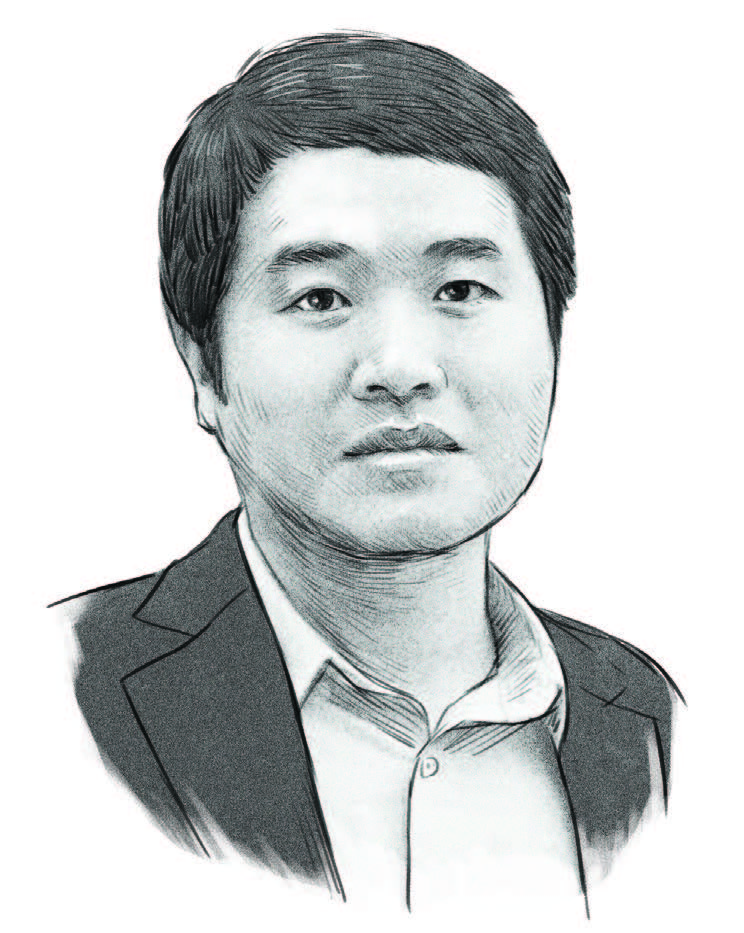W e, our center, do not want students who just ‘TRY MY BEST’. We want ‘THE BEST’ students.’ 20 years ago in 2000, at the China Center for Economic Research of Peking University (CCER, founded by Justin Lin Yifu and Hai Wen in 1994), Hai Wen, the vice president of CCER, said these words to Wang Pengfei, who was applying for the CCER Master of Economics Program. At that time, Wang Pengfei did not perform well during the interview, so he blocked Hai Wen’s path to the door and argued ‘I have tried my best’.
Fourteen years later, at the 20th anniversary of CCER's founding, Wang Pengfei recalled the scene in his famous article ‘Legends of CCER’. He wrote that ‘Professor Hai's words shocked me... I felt excited and a little depressed at the same time. I stepped into the Center, and the following three years completely changed my life.’ Wang Pengfei, who has now become an Associate Dean and Professor of Economics at Peking University's HSBC Business School, was a legendary figure at CCER back in those days. Renowned for his research in macroeconomics, he has become one of the most outstanding graduates of Peking University.
Since 2012, he has published more than 30 papers in academic journals, including six papers published by top journals such as
American Economic Review,
Econometrica ,
Journal of Finance and so on. He has been hailed as one of the most productive young economists in the world.
 Wang Pengfei
Wang Pengfei Professor and Associate Dean of Peking University HSBC Business School
Credit Constraints and Heterogeneous Agent Models (HAMs) Will Become an Important Research Area in the Future
As economic integration and globalization deepen, the cross-border economic shock from one economy to another is becoming stronger and stronger. In 2008, the U.S. economic crisis broke out and gradually spread into a global financial crisis, which finally led to a worldwide economic recession. Over the past decade, more and more research has been conducted on the financial crisis. However, the complicated mechanisms behind the financial crisis are still puzzling the macroeconomics research community. Among all the research topics, debt problems and credit management are important factors in the financial crisis, and Wang Pengfei believes that in the next decade, credit will be an important research area in macroeconomics.
In addition, he has said that heterogeneous agent models (HAMs) and their combination with information frictions would be the future direction of macroeconomics research. Existing macro models focused on economy as a whole, and observable variables are limited to GDP, consumption, investment, stock and real estate prices, and interest rates. These features make it difficult to judge correctness of the implications given by different models. However, HAMs adopt micro data to identify differences between models, and researchers can use them to study the transmission path of how exogenous shocks affect economic variables.
Thus, HAMs are able to explain economic phenomena more accurately than traditional macroeconomic models. For example, most of the existing policy research discusses the impact of economics policies on economic aggregates. But in fact, the influence of policies varies from one group of people to another. So, the same monetary or fiscal policy can have distinct impact when the income distributions are different. In a word, macroeconomic policy research also needs a micro perspective. On the use of data, Wang Pengfei suggested supplementing macro data with micro data.
One of the reasons is that Chinese microeconomic data (such as industrial survey data, customs data, and household survey data) are of better quality. He said that nowadays few micro data were currently being used by macroeconomists. He believed that, if a researcher could understand these databases and use them in macro studies, his or her innovation in these fields would be very promising.
Why Am I Interested in Asset Bubbles?
Not only did Wang Pengfei recognize the importance of these models, but he is also diligently carrying out research on three major topics: asset bubbles, credit, and information asymmetry. In a paper published in the American Economic Review, he and his co-authors suggested that credit constraints could lead to asset bubbles. As a result of corporate credit constraints, there is a positive feedback relationship between the price of collateral and credit. Since firms use their physical capital and firm’s intrinsic value as collateral for loans. As asset bubbles push up firms' stock prices, banks lend more to firms, which in turn boosts firms' investment, and generates positive returns. Thus, this mechanism creates a positive feedback effect that leads to a further strengthening of asset bubbles in stock prices.
In fact, Wang was interested in this area 20 years ago. In the 1980s, there was a huge wave of orchid speculation in China, and the price of the monarch orchid rocketed up to ten million RMB and above. Besides, there was a philatelic fever in the early 1990s, when the price of monkey stamps boomed. At that time, the domestic financial market was opening up to ordinary Chinese citizens and people were eager to speculate and get rich overnight after the shortage of food and clothing had been solved. Wang Pengfei was confused by these phenomena at that time, so he went to read some introductory literature on asset bubbles. He learnt that in the early days of the Netherlands, there was a similar situation, when the price of a single tulip bulb could be equal to the lifetime earnings of 20 skilled workers. Then, the bubble quickly burst, and the price of tulips slumped to the level of other flowers.
Unfortunately, China still witnesses orchid fever every few years. During the bubble, many buyers simply consign the flowers to the florists, where the orchid is sold directly to other speculators without physical delivery. ‘The orchid itself did not bring utility to the investors.’ Wang claimed. He cited a vivid example: In 2006, a Hong Kong investor bought an orchid in Yunnan at a price of 660,000 RMB. Seven years later, the price dropped to only 100 RMB, and that was because a scarce breed that was costly 7 years ago could become commonplace 7 years later. Ironically, the orchid buyer went to court, claiming that he had not made a physical settlement and so did not recognize the deal.
When Wang was a graduate student, there was a huge debate in the academia on the Chinese stock market. Some scholars argued that the Chinese stock market was a casino, while others believed that it provided a great impetus for economic reform. At that time, Chinese stock prices were extremely volatile, and a number of famous speculators rushed to overhype and speculate their stocks. One of the most famous examples was the so-called ‘Kind Dealer’ Delong Group, whose stock price collapsed after extracting a huge amount of wealth from the stock market by speculating their stock price. In the real estate sector, house prices in major cities such as Beijing, Shanghai and Guangzhou, are now about a thousand times higher than their monthly rents. ‘These phenomena are related to the asset bubble’ Wang said.
Asset bubbles are there, around us, and closely related to our daily lives. They sparked Wang's interest and, since graduate school, his research has focused on macroeconomics, asset bubbles, and information frictions.
The theoretical model of Wang and his co-workers covered the weaknesses of existing theories. In the field of asset bubbles, traditional research mostly used two-period models, which had the advantage of simplicity in theoretical analysis. However, their weakness is that it is difficult to use the real economic data to validate the theory, since real data frequency match poorly with the model. In addition, traditional models emphasize the dynamic ineffectiveness of markets, which can lead to a negative linkage between asset prices and the real economy. These models predict that increasing investment in bubble assets would crowd out investment in real assets and thus reduce aggregate output. However, the theory cannot explain why the economy would suffer a recession after the bubble burst.
Wang and his co-workers found that, most of the historical short-term volatility in U.S. stock prices is due to asset bubbles. Based on this finding, their latest theoretical model further explained the mechanism of economic volatility, including the impact of asset bubbles on capital inflows, the impact of government policy on asset bubbles, and what is the optimal policy.
What Caused the Asset Bubble?
Since 2008, China's economy has been experiencing a capital bubble fever. In 2008, 4 trillion RMB in monetary injections opened up the cycle of currency expansion, causing asset bubbles. One of the consequences was excessive leverage. According to the estimation from the IMF, China's macro leverage ratio is currently about 256%, which means that the annual macro interest cost is up to 12 trillion RMB.
In China, asset bubbles are mainly real estate bubbles. According to the 2015 National Urban Housing Market Survey Report, jointly released by Tencent, China Real Estate Business News, and other institutions, China's major housing vacancy rate in major cities ranges from 22% to 26%. According to international empirical data, when the vacancy rate for commercial housing reaches 10%, serious economic bubbles will be formed. In addition, statistics reveal that the average annual increase
in housing prices of second-hand houses was 14.3% in Beijing from 2013 to 2018, which is 8.3 percentage points higher than the increase in rents. These phenomena indicate the existence of asset bubbles in the current Chinese real estate market.
So, what caused the asset bubbles? Typically, real estate has two functions, a residential utility function and an investment function. Wang Pengfei pointed out that different people had different demand for houses, or in other words, different marginal utility on housing. Marginal buyers in the market determine house prices, and during credit expansions, the utility of marginal buyers increases. However, house rents represent the average utility of all housing demanders, and they do not increase with the credit expansion. This explains why house prices have risen far more than rents.
Wang further explained that credit expansion is one of the main causes of asset bubbles, especially real estate bubbles. For example, the Federal Reserve cut interest rates 11 times, from 6.5 percent to 1.75 percent in 2001, and since then, the U.S. has witnessed the biggest real estate bubbles in history.
In addition, high savings rate is a special feature of China's economic development. China's savings rate ranks first among large countries and Chinese people have strong saving motives. The reason is that, in a state-run economy during the past, people had a good pension and medical benefit provided by SOEs, and those benefits are no longer provided by private enterprises since China turned to a market economy. This benefit cut, coupled with an imperfect social security system and the One-child Policy, drove people to save more. Wang thought this was also an important reason in the creation of asset bubbles.
However, it is difficult to fully explain the build-up of massive asset bubbles in the Chinese market through credit expansion and high savings rates, because bubble assets do not generate cash flow, and they are easily replaced by other high-quality assets. Wang pointed out that the lack of incentive mechanism and the weak value discovery function of the Chinese capital market, lead to a shortage of quality assets. This is another reason explaining why the problem of asset bubbles remains even though the Chinese savings rate has been in decline since 2010.
From SIQEF Newsletter Issue 02
Published in the PHBS Magazine

















